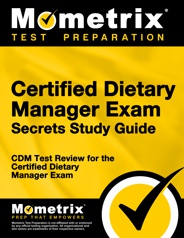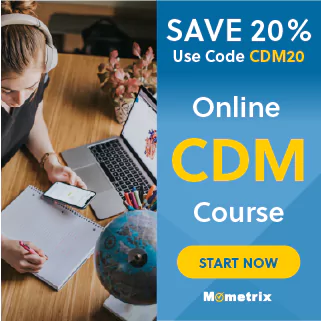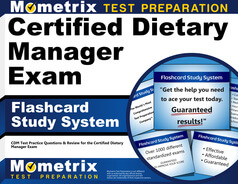The Certified Dietary Manager (CDM) Exam measures your ability to ensure food safety, make purchases, create and implement menus that meet the nutritional needs of patients or customers, and handle other tasks associated with being a dietary manager.
Click “Start Test” above to take a free Certified Dietary Manager practice test!
Certified Dietary Manager Exam Eligibility
To be eligible for the CDM exam, you meet one of the following requirement pathways:
For this pathway, you must have graduated from an ANFP-approved food service manager training program.
Pathway 2
For this pathway, you must have graduated with at least a two-year degree in food service management, hotel-restaurant management, culinary arts, or nutrition.
Pathway 3a
For this pathway, you must have graduated from a comprehensive food service course (with a minimum of 90 hours) and must also have at least two years of full-time experience with non-commercial food service management.
Pathway 3b
For this pathway, you must have graduated from an ANFP-approved food service manager training program and must also have at least two years of full-time experience with non-commercial food service management.
Pathway 4
For this pathway, you must be a current or former member of the US military, and you must have graduated from a training program in dietary management, food service management, or culinary arts training (with a minimum of 90 hours).
Pathway 5
For this pathway, you must have graduated with an alternate degree of at least two years, and you must have obtained at least five years of full-time experience with non-commercial food service management.
Certified Dietary Manager Exam Outline
The Certified Dietary Manager Exam contains 160 multiple-choice questions, 20 of which are unscored, and you will be given a 3-hour time limit. The unscored questions are unmarked and spread randomly throughout the exam, so you will not know which questions are scored and which are unscored. The test administrators include these questions to test their validity for use in future versions of the exam.
The exam is split into five content domains:
1. Nutrition (20%)
The questions in this domain cover the various aspects of nutrition data and education.
Gather Nutritional Data
- Interview for nutrition information
- Document nutrition information in medical records
- Obtain routine nutrition screening data
- Identify client rights and nutrition problems
Apply Nutrition Data
- Manage diet plans
- Manage written diet orders
- Apply a standard nutrition care plan
- Review the effectiveness of the nutrition care plan
- Manage supplemental nourishments in concordance with the written diet order
Provide Nutrition Education
- Assist clients with food selection
- Use nutrition education materials
2. Foodservice (22%)
The questions in this domain cover the various aspects of food prep, recipes, and quality improvement procedures.
Develop Standardized Menus
- Use nutritional resources
- Adhere to regulatory diet requirements
- Develop a menu that considers client preferences
Ensure Effectiveness of Standardized Recipes
- Identify standardized recipe elements
- Use food charts and references to compute portions
- Develop cooking procedures
- Calculate the cost and nutrition content of standardized recipes
- Evaluate the client’s acceptance of new recipes
Specify Standards and Procedures for Preparing Food
- Develop food quality control standards
- Monitor food production by implementing specific procedures
- Monitor food waste by developing specific procedures
- Monitor food preparation and production
Manage the Preparation, Production, and Distribution of Food
- Define procedures for various types of foodservice
- Monitor the adherence to delivery procedures and schedules
- Keep records for accountability and monitoring
- Calculate the efficiency of the foodservice system
- Define foodservice production schedules
- Define special event food preparation and production needs
- Forecast recipes, menus, diet census, preparation sheets, production sheets, retail needs, and tally sheets
Monitor Meal Service
- Verify portion size, diet accuracy, and quality
- Assure meals are served as posted
Establish Continuous Quality Improvement Procedures for Foodservice Department
- Define foodservice objectives and standards
- Monitor quality indicators
- Implement procedural changes
- Analyze and interpret data for reports
- Implement an auditing tool to determine quality indicator effectiveness
3. Personnel and Communications (20%)
The questions in this domain cover the various aspects of job functions, education, employee assignments, goals, and professional interactions.
Define and Develop Personnel Needs and Job Functions
- Conduct personnel needs and task analyses
- Write job descriptions and specifications
- Recommend advertising strategies for open positions
- Update departmental organizational charts
Interview, Select, and Onboard Employees
- Comply with fair employment practices and laws
- Decide on applicants and record the data in a file
- Document interview and selection policies and procedures
- Provide initial job-specific training for new employees
- Verify the completion of training and orientation
Provide Ongoing Education
- Provide a follow-up after onboarding and orientation
- Provide in-service training on various safety guidelines, hygiene expectancies, crisis management, and other contemporary issues
- Verify the completion of training
Develop and Maintain Employee Time Schedules and Assignments
- Identify various overall staffing needs and daily tasks
- Determine the capabilities and preferences of available employees
- Develop and maintain a time schedule
- Track absences/tardy records in personnel files
Manage Goals and Priorities for Department
- Develop short-term and long-term department goals
- Participate in developing procedures and policies
- Compare department goals against available resources
Manage Department Personnel
- Maintain personnel records
- Identify termination and promotion criteria
- Compile documentation for termination and promotion
- Conduct performance evaluations
- Recommend adjustments for wages and salary
- Correct a problem by following disciplinary procedures
- Ensure employees’ compliance with procedures
Manage Professional Interactions and Development
- Participate in regulatory agency surveys
- Participate in meetings that occur outside the department
- Communicate client information to other health professionals
- Participate in client care conferences
- Manage department meetings
- Adhere to the professional code of conduct
Implement Departmental Changes
- Identify existing problems and needs
- Implement a plan of action
- Evaluate the changes’ effectiveness
4. Sanitation and Safety (24%)
The questions in this domain cover the various aspects of nutrition data and education.
Manage Personnel to Ensure Compliance with Safety and Sanitation Regulations
- Identify federal, state, and local safety laws
- Develop cleaning procedures for work areas, equipment, and utensils
- Evaluate equipment in terms of maintenance needs and costs
- Inspect all areas of the department for sanitary conditions
- Educate employees in safety and sanitation
- Interpret OSHA regulations
- Enforce the compliance of employees with sanitation and safety regulations
Manage Purchasing, Receiving, Storage, and Distribution of Food and Supplies Following Established Sanitation and Quality Standard
- Identify the appropriate grades and inspections for food
- Procure food and water from approved sources
- Verify the quantity and quality of food supplies and equipment received
- Check supplier invoices against the facility purchase orders
- Recognize the hazards associated with types of food packaging
- Recognize signs of contamination upon receipt and in storage
- Process rejections for unacceptable products
- Manage receiving and storage temperatures
- Ensure rotation by labeling, dating, and monitoring food
- Prevent environmental contamination
- Maintain security procedures
Protect Food in all Phases of Preparation Using HACCP Guidelines
- Identify potentially hazardous foods and foodborne pathogens
- Recognize the types, causes, and symptoms of foodborne illnesses
- Monitor time and temperature to destroy or limit the growth of microorganisms
- Prevent food cross-contamination
- Identify appropriate temperature retention techniques
- Ensure food is cooled safely
- Establish critical limits and the corrective actions to be taken when critical limits are exceeded
- Establish procedures to identify and monitor critical control points
- Establish effective recordkeeping systems that document HACCP
- Prepare emergency procedures that are necessary to ensure a safe food supply
- Develop a crisis management plan to address an outbreak of a foodborne illness
Manage Physical Facilities to Ensure Compliance with Safety and Sanitation Guidelines
- Identify federal, state, and local safety laws
- Conduct routine maintenance inspections of equipment
- Organize the workflow and use of equipment
- Identify appropriate environmental controls for ventilation, waste disposal, and water supply
- Follow an integrated pest management (IPM) system
- Prepare a safety inspection checklist
- Write an inspection report on hazards
- Assure that the equipment, utensils, chemicals, and space have been cleaned and sanitized
5. Business Operations (14%)
The questions in this domain cover the various aspects of budgeting and implementing cost-effective procedures.
Research, Develop, and Manage an Operating Budget
- Determine the needs of the facility
- Compute menu costs
- Calculate the daily cost PPD
- Monitor productivity and expenses
- Advocate personnel costs for a foodservice department
Research, Develop, and Manage a Capital Budget
- Evaluate the condition and life expectancy of existing capital equipment
- Develop the needs and requirements of capital expenditure
- Evaluate options for the replacement or upgrade of capital expenditures
- Write a budget proposal for new capital equipment
- Recommend specifications for new capital expenditures
Plan and Budget for Improvements in the Department Design and Layout
- Conduct a department improvement discussion session with staff members
- Communicate recommendations for improvement
- Evaluate workflow and essential equipment relative to new department designs or construction
- Research concepts related to the department’s facility design
- Prepare proposals and specifications for new construction or renovations in the current layout/design
Manage the Purchasing Process
- Identify the department’s purchasing procedures and policies
- Be responsible for vendor product/selection
- Establish purchasing specifications
- Evaluate the facility’s needs, budget restrictions, and products availableIdentify purchase needs by checking inventory
- Complete purchase order requisition forms
- Perform and maintain inventory management practices
Manage Revenue Generating Services
- Manage and audit cash activities and reports
- Calculate the cost to set prices for retail/catering
- Plan foodservice and menus for retail/catering
- Balance the revenue budget by using cost-control techniques
- Research, analyze, and/or promote revenue-generating opportunities
Implement Cost-Effective Procedures
- Manage cost-saving purchasing practices
- Manage cost-saving department practices
- Report the variance of budget costs versus actual costs
Check out Mometrix's Certified Dietary Manager Study Guide
Get practice questions, video tutorials, and detailed study lessons
Get Your Study Guide
Registration
To register for the CDM exam, you must first create an online ANFP account. Through this account, you can submit an application, along with all of the required documents for your eligibility pathway and the $425 examination fee. If your application is denied, your fee will be refunded (minus a $50 processing fee).
If your application is approved, you will receive a confirmation email with more information about how to schedule your examination appointment.

CDM Online Prep Course
If you want to be fully prepared, Mometrix offers an online CDM prep course designed to give you everything you need to succeed!
Here’s what you’ll find in the CDM course:
- 40+ Review Lessons Covering Every Topic
- Over 300 CDM Practice Questions
- 250+ Digital Flashcards
- Money-back Guarantee
- Mobile Access
Everyone learns differently, so we’ve tailored the CDM online prep course to ensure every learner has what they need to prepare for the CDM exam.
Click below to check it out!
Test Day
You should arrive at the testing center at least 15-30 minutes earlier than the scheduled appointment time. Upon arrival, you will be asked to show two forms of valid identification and sign the Rules and Regulations Agreement.
Once you are signed in, you will be asked to place all personal items in a nearby secure locker. This includes items like your cell phone, wallet, bag, books, and food items.
Before the exam begins, you will have an opportunity to take a quick practice exam to become familiar with the format and computer system. Once this practice exam is complete, your real exam will begin.
Once the exam begins, you may take breaks, but the timer will not be paused at any point.
How the CDM Exam is Scored
The exam is scored using a scaled system that adjusts your raw score (the actual number of questions you answered correctly) according to the relative difficulty of the questions you answered.
Because the score is scaled in this way, the actual number of questions you need to answer correctly will vary depending on which version of the test you took. For more difficult versions, the minimum number of correct answers could be as low as 98 while easier versions of the test could be as high as 105 out of 140.
Generally, answering 70% of the questions correctly is considered a passing score.
You will find out whether you passed immediately after the test. If you are an ANFP (Association of Nutrition and Foodservice Professionals) member, your certification will also become activated instantly once you have passed the exam.
Check out Mometrix's Certified Dietary Manager Flashcards
Get complex subjects broken down into easily understandable concepts
Get Your Flashcards
FAQs
Q
How many questions are on the CDM exam?
A
There are 160 multiple-choice questions on the exam.
Q
How long is the CDM exam?
A
The time limit for the exam is 3 hours.
Q
What is the passing score for the CDM exam?
A
There is not set passing score for this exam, but answering 70% of questions correctly is generally regarding as a good enough score to pass.
Q
What is the pass rate for the CDM exam?
A
The pass rate for this exam is 74%.
Q
How much does the CDM exam cost?
A
The examination fee is $425.


